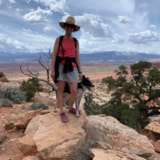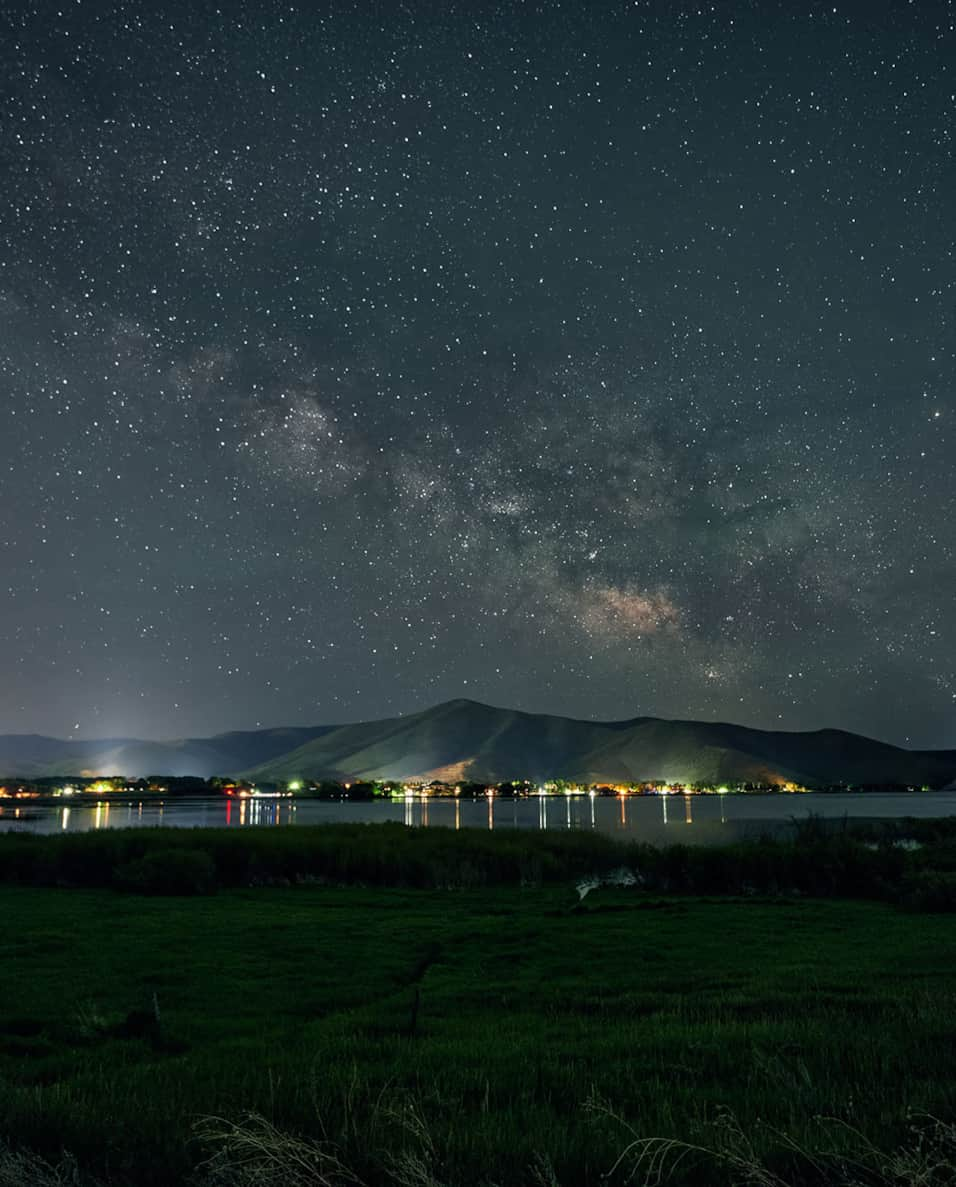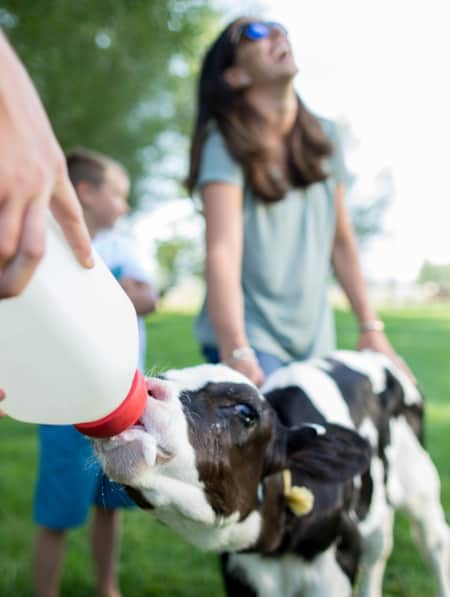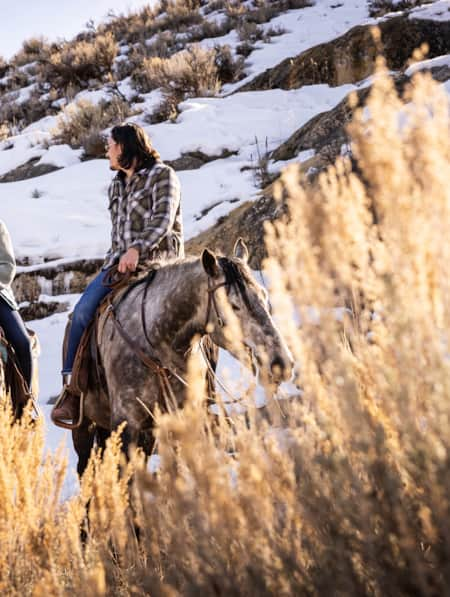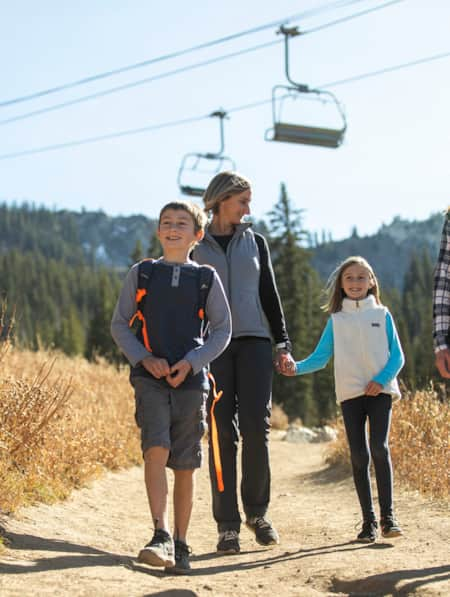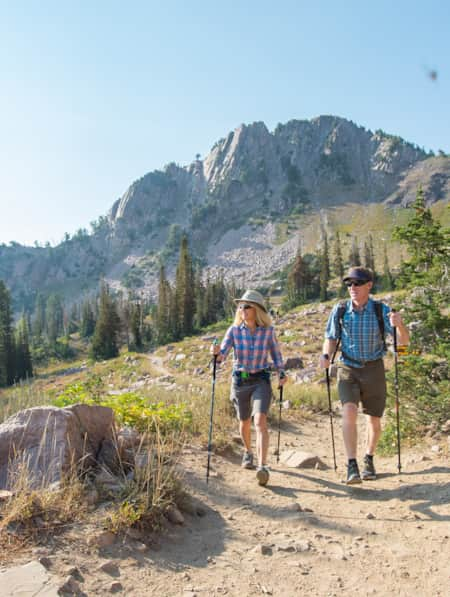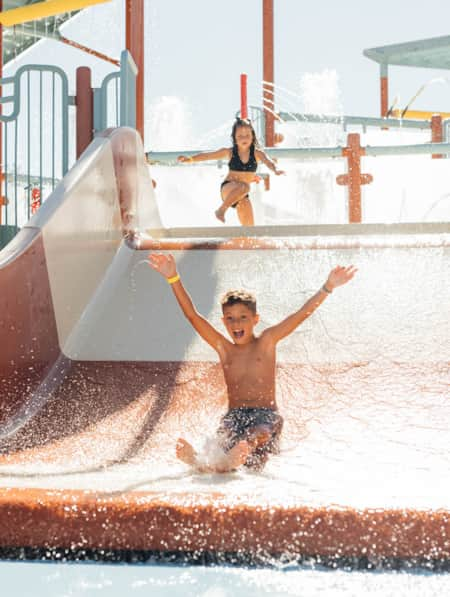Swiss Traditions Meet Mountain Adventure in Utah's Heber Valley
In the Heber Valley, visitors can find a mountain playground steeped in authenticity, heritage, and come-as-you-are hospitality.

“From your downward-facing dog, raise your right leg toward the sky, and bend your knee,” says Blake Summers of Park City Yoga Adventures. “Begin to move your heel down toward your hip. Keep going and flip your dog into the water.”
As I splash down into the warm water beneath my paddleboard, I open my eyes under the surface for a second, peering into the depths of the 50-foot water-filled fissure in the earth below me. I’m more than a little relieved when all I see through the crystal-clear waters is the rocky sides of the hot spring all the way to its bottom.
I suspect that at this moment, nowhere else on earth is this practice happening: A paddleboard yoga class inside a domed crater filled with the mineral-rich waters of a 10,000-year-old geothermal hot spring. The Homestead Crater — tucked along the western side of Utah’s Heber Valley in the quaint town of Midway — is a hot spring fed by Wasatch Mountain snowmelt that’s heated within the earth and percolates up to the surface. An opening in the top of the crater’s limestone dome lets in sunlight and fresh air while the crater’s waters stay at an inviting 90 to 96 degrees, year-round.

The Homestead Crater is a hot spring fed by Wasatch Mountain snowmelt that’s heated within the earth and percolates up to the surface.

Inside the crater, you can swim, scuba or partake in a paddleboard yoga class. Just be sure to make your reservation early.
While practicing floating yoga in a hot spring crater is certainly out of the ordinary, its existence seems par for the course considering the many things to do in the Heber Valley. In the crater, you can also scuba dive and swim — just be sure to make your reservation early. Outside the crater, the laundry list of distinctive attractions in the Heber Valley includes three Utah State Parks, a 2002 Olympic Winter Games venue, the state’s only operating heritage railroad line, two reservoirs and a nationally recognized cheese factory and chocolate factory — just for starters. But to understand the Heber Valley’s unmatched offerings, it makes sense to take a look at its beginnings.
Swiss Home Away From Home
Native Americans were the first to discover the Heber Valley area, likely dating back to 1000 CE. The Timpanogos Ute Tribe spent summers here, taking advantage of cool temps and abundant game in the valley and surrounding mountains.
In 1857, workers at a sawmill in Big Cottonwood Canyon hiked up the mountainside to the Wasatch Range’s Crest. From there they laid eyes on a green valley reputed to be a “paradise land.” The next year Brigham Young, the then-president of The Church of Jesus Christ of Latter-day Saints, ordered construction of a road linking Provo to the valley that would eventually be named after another early Latter-day Saints’ leader, Heber Kimball.
Today, whether you arrive in the Heber Valley from the north along Highway 40, from the south through Provo Canyon via Highway 189, or through Big Cottonwood Canyon along the Guardsman Pass Scenic Backway (open in the summer and fall only), you are rewarded with sweeping views of craggy peaks surrounding lush, green lowlands. Those vistas make it easy to imagine how those mill workers, and in turn, local leaders, were immediately taken with the area.
The valley’s alpine-like landscape also attracted the attention of Swiss immigrants, who began arriving in Utah following completion of the Latter-day Saints’ first European temple in Bern, Switzerland, in 1955. Several Swiss families settled and eventually founded the valley town of Midway, building a life based on what they knew: dairy farming and cheese production (Read: Historic Heber).

When arriving in the Heber Valley, you are rewarded with sweeping views of craggy peaks surrounding lush, green lowlands.

Stop at Heber Valley Artisan Cheese to pick up a selection of the Koehler Family’s locally-produced cheeses, jams, ice creams and other foods.

Swiss roots take centerstage every Labor Day weekend with Midway Swiss Days, held in this charming hamlet’s town square.
Swiss immigrant Gotlib Kohler was among the Heber Valley’s first settlers. His descendants continue to carry on Midway’s more than century-old creamery legacy with Heber Valley Artisan Cheese. This small dairy farm of about 150 Holstein cows hosts a creamery shop where visitors can sign up for dairy tours and sample the creamery’s award-winning cheeses.
Midway’s Swiss roots take centerstage every Labor Day weekend with Swiss Days, held in this charming hamlet’s town square. More than 80,000 people gather for the two-day event (Friday and Saturday) to shop handmade crafts, sample Swiss-themed food and take in performances by local musicians and entertainers. All Swiss Days proceeds are reinvested in Midway, funding the town’s annual flower planting and Christmas light displays, local student scholarships and more. “Swiss Days started decades ago as a farmer’s market,” says Aja Phillips, Swiss Days organizing committee member. “Now I’d say while the event is still very much Swiss-themed, it’s become more about service to and celebration of the community as it is today."
Outdoor Recreation Nirvana
Now, though the Heber Valley is a far cry from the untouched “paradise land” those mill workers described when they looked down from the top of the Wasatch Crest, development of the valley has occurred with priority placed on preserving open space, mostly for recreation (Read: Wild Heber). The valley’s outdoors-facing ethos is what attracted Maryland natives Jerry and Nancy Geisler to retire there in 2019. “We had to be somewhere where we could ski, bike, paddle and golf,” Jerry says. “All those things are right here and there’s even more options very close by.”
Geisler’s claim that the Heber Valley sits at the confluence of multiple outdoor pursuits isn’t hyperbole. Along the valley's west side is Wasatch Mountain State Park, a 22,000-acre playground dedicated to picnicking, camping, off-road vehicle exploration, hiking, mountain biking, stargazing, Nordic skiing and snowmobiling. The park also boasts two well-maintained and nationally renowned golf courses, dubbed the Mountain and Lake.
In the park’s southeast corner is Soldier Hollow Nordic Center, a 2002 Olympic Winter Olympics venue and public recreation center. Winter activities at Soldier Hollow include, of course, cross-country skiing, but also include snow tubing, a biathlon experience, and skijoring. In the summer, duffers revel in the challenge offered by the 36-hole Soldier Hollow Golf Course. In May, Soldier Hollow hosts one of the West’s largest sheepdog competitions and festivals, the Soldier Hollow Classic. And then it becomes a mountain biking mecca for the remainder of the warm weather months.

Are water sports more your thing? The Provo River, Deer Creek Reservoir and Jordanelle Reservoir all provide access to boating, sailing, fishing, paddleboarding and more.

The Heber Valley is home to three Utah state parks and two reservoirs boasting spectacular views and recreation.
The Heber Valley’s outdoor pursuits aren’t limited to Wasatch Mountain State Park, however. Watersports — from water skiing and paddleboarding to kiteboarding and sailing — are enjoyed at the nearby Deer Creek and Jordanelle reservoirs. Anglers cast lines year-round at various public access points along the Provo River, which runs through the heart of the Heber Valley between the two reservoirs (Read: Finding Solitude on the Provo River). Twenty-three miles to the southeast is the remote Strawberry Reservoir, a Blue Ribbon fishery tucked into the Uinta National Forest.
Though nearby Park City is considered an unofficial center of Utah’s ski-dom, the Heber Valley should be ranked a close second. Skiing at Deer Valley Resort is just 10 miles north of downtown Heber at the resort’s Jordanelle Express Gondola; both skiing and snowboarding can be had just seven miles beyond Park City Mountain’s in-town base; and the dreamy Sundance Resort is located 17 miles to the south of valley proper through Provo Canyon.
Other outdoor activities in the Heber Valley horseback riding, hot air ballooning, bird watching and river rafting.
Where the Welcome Mat is Spread
Back at the Homestead Crater, Blake wraps up our floating yoga class with what I’ve been craving. “For our final pose, slide off your board into the water, lean back and float in the water while keeping a hand on the board,” he instructs.
And as I hover in the soothing waters, I think about the Heber Valley’s laundry list of things to do, and its authentic and increasingly rare hospitality. Whereas other mountain communities across the West seem to be putting most of their efforts toward limiting visitors, the Heber Valley, at least for now, is keeping the welcome mat out and its doors wide open.



